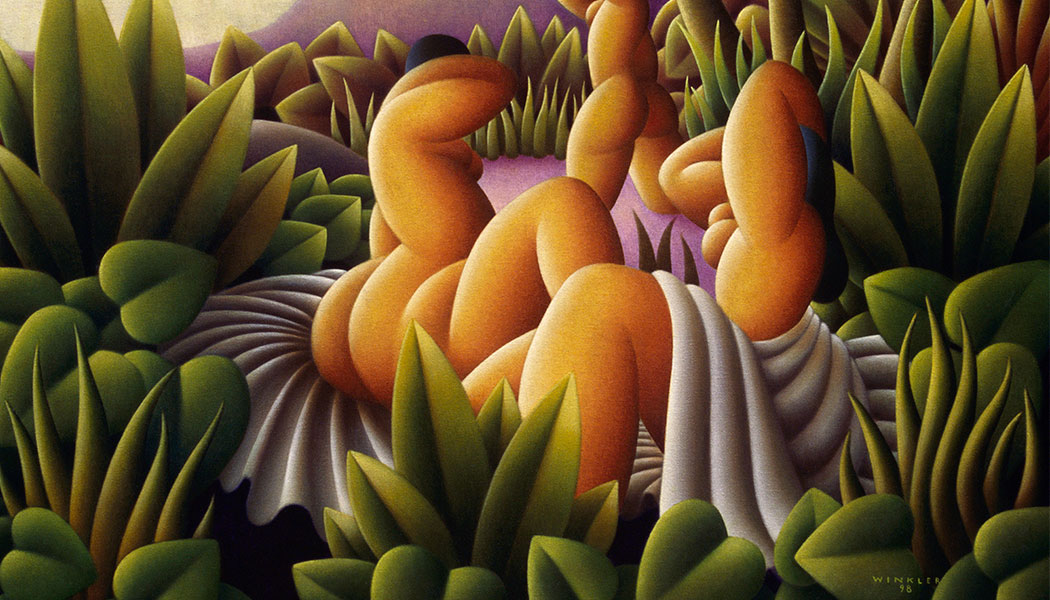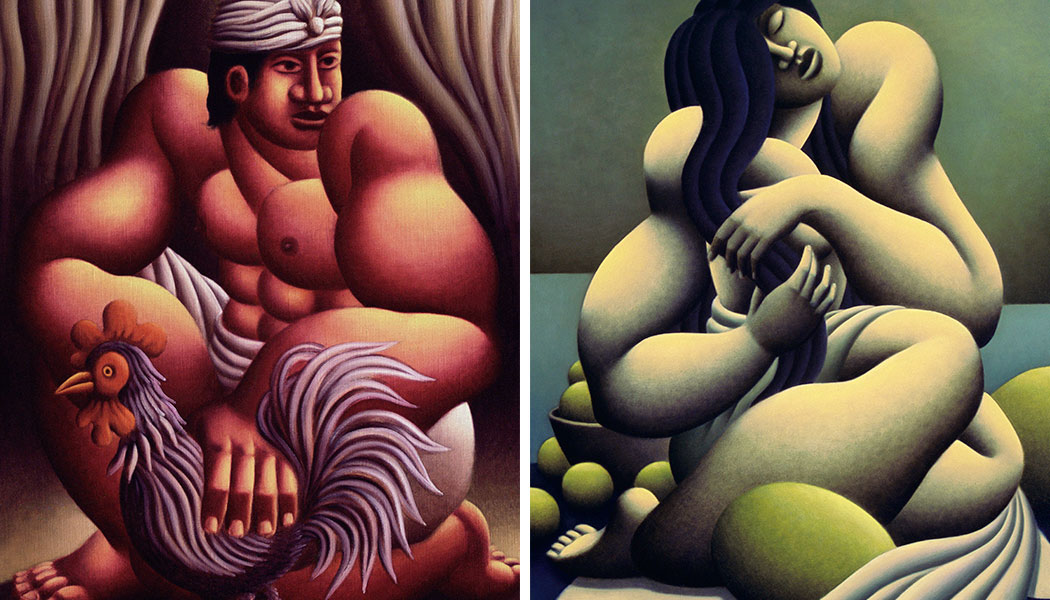Botero meets Spies in Richard Winkler’s extraordinary vision of the Balinese. Words: Richard Horstman. Portraits: Saskia Koerner.

Although Swedish artist Richard Winkler’s creative development charts a course that isn’t unlike other artists who settle in Bali, he has, however, succeeded in doing what few foreigners in this country can do. Winkler’s paintings have created a niche within the large, yet competitive and nationalistic, Indonesian art world.
Within his sensual paintings Winkler creates a utopian Bali landscape. Set within fantastic tropical scenarios, his compositions feature figures, bulbous and distorted, that reflect the diverse nature of the human DNA that manifests in countless different body forms and sizes, from obese to beautiful, the vigorous to the unwell. They contain the extraordinary story of his own body, and the personal experience of having to cope with a rare bone disorder. From an early age painful boney growths continued to reappear on Winkler’s limbs, and he had to undergo regular surgery to have them removed.

The passage of time, however, granted him the wisdom to transcend the challenges faced in his formative years. “These experiences taught me to love and honour the physical vehicle in which I was born,” Winkler says. “They have inspired me, and have helped develop a resilient character. Because of this I have an enormously positive outlook on life,” and he continues, “I resonate with the abstract nature of my figures. Subconsciously a part of me springs forth, and in the studio my own unique creative process comes to life.”
The natural environment, both here in Bali, and where he grew up in Sweden, have left an eternal impression upon the artist. In 1995 Winkler first encountered the splendors of the equatorial zone. “While in Sri Lanka I discovered another world – the tropics. It was so beautiful, and unusual from anything else I had seen. The light and the colours were all so different, and amazing. I was stunned.”
In 1997 he relocated from Europe to Ubud, following his heart to be with his Indonesian love, Regine, who was his pen pal since their secondary school years. They rented a house overlooking the lush ravines of Campuhan, and in his studio Winkler set to work. Consequently his oeuvre began to evolve. Icons of the local culture were depicted along with the figurative form, yet the new highlight was his interpretations of the rich tropical landscape.

Born in 1969 in Norrköping, Sweden, Winkler’s formal art education was at the Nyckelviken School of Art. He then studied graphic design and illustration at the Beckman’s School of Design in Stockholm, and for some years he worked as an illustrator for advertising and magazines. Life-model drawing classes were an essential for honing his sketching skills.
At a glance Winkler’s paintings are a fusion of subtle arcs, appearing as a ‘sea of curves’. His exaggerated human shapes with bulging backsides, torsos and limbs insight humour. The opulent scenes pulse tranquil frequencies, as colour psychology nourishes the senses and mind. As metaphors for the omnipotent fertility of the universe, they are celebrations of the beauty of Bali.
“Art is a personal expression, emotional and instinctive, that I love to share. I believe you have to have a story in some form to tell, whether it is something you are aware of, or from your subconscious mind. The audience does not necessarily need to know your story, but they do need to feel it, and connect with its emotions.”

“My artistic career has always been about expressing my private passions and experiences. I have always been searching for the beauty and harmony in the world, in nature, between man and nature, and in life itself. Art is all about truth and honesty,” Winkler says.
About 12 years ago Winkler decided to modify his concepts into three dimensional forms and initiated the process of experimentation and learning how to create sculptures. First he was to construct and “play” simplistic models, and from there his process grew. Soon he was forging impressive sculptures in bronze.
These are monumental reclining figures, some more than two meters in height. To achieve the perfect symmetries in his works requires patience and skill, so during the process he must continuously run his hands over the extremities of the models to identify and correct any imperfections he finds.

The models are then dismantled and transferred to a foundry, and reassembled for the liquid casting process, and next the finishing is done. Finally these characters are set in position, often appearing as if they have grown up and out through the earth, grounded and strong.
“My paintings were already very sculptural in a way, so it was a natural progression for me to transform my ideas into sculpture. I wanted to see how my figures would turn out in the three dimensional world.”
Reflecting upon artistic growth and maturity after living on Bali for 20 years Winkler says, “I believe that it is always the hunger to improve and achieve that drives you forward. The day when you feel completely satisfied and fulfilled, the game is over. Patience and dedication are equally important in art, and in life. Skills, knowledge and personality are not created overnight.”

Imagination is an extraordinary faculty when applied to a painting’s descriptions. It presents us freedoms from our experiential worlds, and openings to alternative realms close at hand. What we engage with when we ponder Winkler’s paintings is ‘distance’ – a sense of space, far from the here and now.
“My paintings offer reverence to the cycles of life, and life itself. To those who work hard without question, and accept their fate as it is, life and death, planting and harvesting. I pay homage to the humble ones. Yet I strive to create a window to dream away to a world which does not really exist, more than in our hearts, and minds.”
I often imagine an environment, or state of things in which everything is perfect, not too dissimilar to what Winkler creates. What I wish for however, I wish for everyone else. For those who hold their own global vision of harmony, images of utopia are essential during these increasingly chaotic times.
































